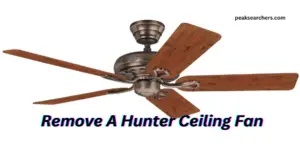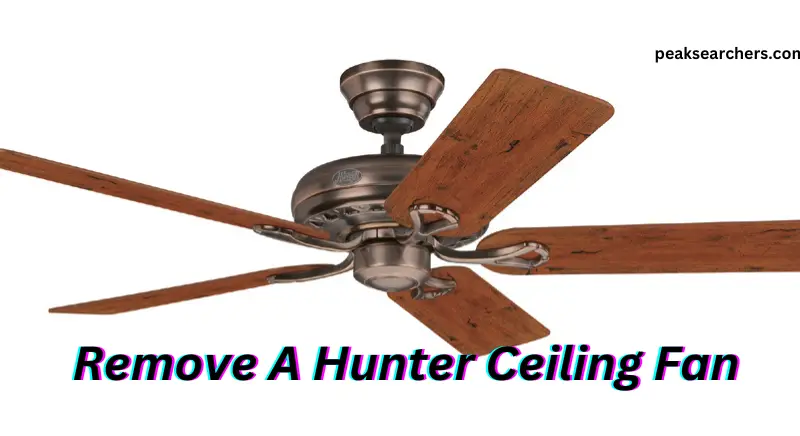How To Remove A Hunter Ceiling Fan – A Step By Step Guide
When it comes to home renovation or remodeling, one of the most common things that homeowners often change is their ceiling fans. Ceiling fans are a great addition to any room, providing both comfort and style. However, over time they may need to be replaced for various reasons such as malfunctioning or outdated design.
Once, I wanted to change my Hunter ceiling Fan but did not know how to exactly do so. Then, I searched through the internet and found out that it was probably easier than a normal fan.
If you have a Hunter ceiling fan that needs removing but doesn’t know where to start, don’t worry! In this step-by-step guide, we’ll take you through the process of removing your Hunter ceiling fan safely and efficiently.

Troubleshooting steps
Follow some of the steps in order to remove your Hunter fan. You need to make sure that you read the article till the end. The last step is most important because it finalizes if you have successfully removed your fan or not.
Step 1: Shut Off the Power Supply.
Before attempting to remove a Hunter ceiling fan, it is important to shut off the power supply. This will ensure that you do not accidentally electrocute yourself during the removal process.
To shut off the power supply, locate your home’s circuit breaker or fuse box and turn off the switch that controls the electricity going to the room where your ceiling fan is located.
If you are unsure which circuit breaker controls the electricity in your room, turn off all of them until you find the right one. It is also a good idea to use a non-contact voltage tester to confirm that there is no electrical current flowing through any wires before proceeding with removal.
Once you have turned off the power supply and verified that there is no electrical current flowing through any wires in your ceiling fan, you can move on to Step 2.
Step 2: Remove Blades & Globe
Once the fan has been turned off and the power source has been disabled, it is important to remove the blades and globe before attempting to take down the entire ceiling fan.
To remove the blades, first, locate the screws that attach them to the motor housing. Depending on your model of Hunter ceiling fan, there may be either two or three screws per blade. Use a screwdriver to loosen these screws and then gently pull each blade away from its mounting bracket.
To remove the globe, locate any screws or decorative elements that are holding it in place. Again, this will vary depending on your specific model of Hunter ceiling fan. Once you have identified these elements, use a screwdriver or other appropriate tool to remove them carefully.
Then grasp both sides of the globe securely with both hands and gently twist it in a counterclockwise direction until it comes free from its housing.
It is important that you take care when removing both blades and globes as they can be fragile and easily damaged if mishandled. By following these careful steps, however, you should be able to successfully remove each element without causing any harm or damage to your Hunter ceiling fan.
Step 3: Disconnect Wiring
Before proceeding with the removal of your Hunter ceiling fan, you need to disconnect the wiring. This step is crucial to ensure your safety and avoid any electrical accidents. To start, turn off the power supply from your main circuit breaker. You can do this by flipping the switch that corresponds to the area where your fan is located.
Next, use a voltage tester to check if there’s still electricity flowing through the wires. Place one probe on the black wire and another on the white wire.
If there’s no reading or it shows zero volts, then you’re good to go. However, if it indicates some voltage flow, don’t proceed until you’ve turned off all circuits that connect to your ceiling fan.
Once you’ve confirmed that there’s no more electricity flowing through the wires, remove any tape or wire connectors used to secure them in place. Use a ladder or stool as needed for easier access and slowly pull out each wire from its respective slot in the bracket until they’re completely detached from your Hunter ceiling fan.
Keep track of which wire goes where so that reinstallation won’t be an issue later on. With this step done, you’re now ready for Step 4: Remove The Mounting Bracket And Fan From The Ceiling!
Step 4: Unscrew Hardware
Once you have turned off the power supply to your Hunter ceiling fan, it is time to start unscrewing the hardware. Begin by removing the cover of your ceiling fan’s mounting bracket.
This can be done by loosening and then removing any screws that are holding it in place. Once you have removed the cover, you will need to unscrew and remove the canopy that covers where the electrical wires connect.
Next, locate and loosen any screws that are holding the fan blades in place. Depending on your model of Hunter ceiling fan, there may be three or four screws per blade that will need to be removed. Once all screws have been removed, gently lift each blade from its holder and set them aside.
After removing all blades from your ceiling fan, take a look at your fan motor’s housing. You should see a small rubber plug on one side of this housing.
Remove this plug with pliers or screwdrivers and save it for later use if necessary – depending on what type of replacement part(s) you may need for repair/replacement purposes down the line!
Step 5: Take Down the Fan
Once the blades are removed, you can take down the fan from the ceiling. First, locate the mounting bracket that attaches the fan to the ceiling. This will typically be a metal plate with screws holding it in place. Use a screwdriver to remove these screws and detach the bracket from the ceiling.
Next, disconnect any wiring attached to the fan. This will include wires for power and control of lights or speed settings if applicable. Be sure to turn off the power at the breaker before attempting this step.
Finally, carefully lower the fan and bracket away from the ceiling and set them aside for disposal or storage. With these steps completed, your Hunter Ceiling Fan has been successfully removed!
FAQ’s
Q: What tools do I need to remove a Hunter ceiling fan?
A: You will need a few basic tools to remove your Hunter ceiling fan, including a Phillips head screwdriver, wire cutters or pliers, and a ladder or step stool. Additionally, it can be helpful to have someone else available to assist you with the removal process.
Q: Can I remove my Hunter ceiling fan by myself?
A: While it is possible to remove your Hunter ceiling fan on your own, it is important to use caution and follow all safety guidelines.
This includes turning off the power supply before beginning work and using proper equipment such as sturdy ladders or step stools. If you are uncomfortable performing any part of the removal process yourself, it may be best to hire a professional electrician.
Q: How long does it take to remove a Hunter ceiling fan?
A: The amount of time required to remove your Hunter ceiling fan will depend on several factors including the complexity of the installation and whether you are working alone or with assistance.
Generally speaking, most homeowners should plan for at least an hour or two for this task. It is also important not to rush through any steps in order to ensure that everything is done correctly and safely.
Also read: Fix Hampton Bay Ceiling Fan Remote Not Working – A Complete Solution
Conclusion:
Now that you have successfully removed your old Hunter ceiling fan, it’s time to install a new one. The installation process may seem daunting, but with the right tools and instructions, it can be a breeze.
One of the most important steps when installing a new fan is to ensure that the electrical wiring is properly connected. Be sure to turn off the power at the circuit breaker before starting any work.
Once you’ve disconnected the wires from your old fan, follow the manufacturer’s instructions carefully for your new fan. Most ceiling fans come with detailed step-by-step instructions making installation much simpler than in years past. Some newer models even feature snap-on blades which attach easily without any screws or bolts.
When installing your new Hunter ceiling fan, make sure to double-check all connections before turning on power and switching it on for use. It’s also important to balance and level your fan once installed using weights or adjustable brackets if necessary, ensuring that it runs smoothly and quietly for years to come.


